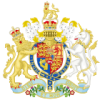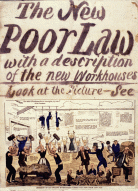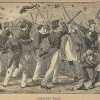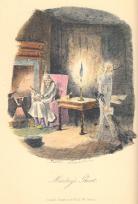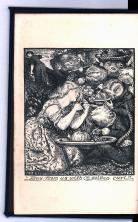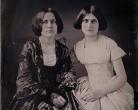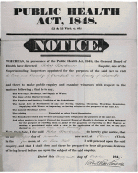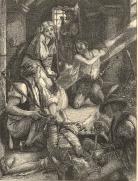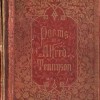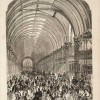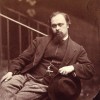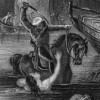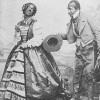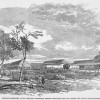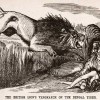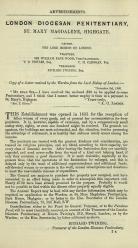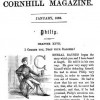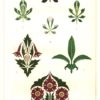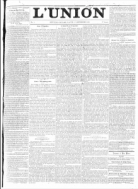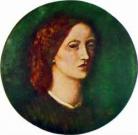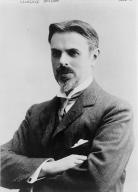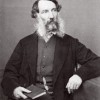Victorian Illustrated Books Timeline
Created by Lorraine Janzen Kooistra on Thu, 08/20/2020 - 16:52
Part of Group:
This Timeline documents events that are key to understanding contexts impacting the authors, artists, publishers, and readers of Victorian Illustrated books, in their own cultural moment and through to the present day. In addition to publishing events, these contexts include biographical, cultural, economic, political, social, and technological events.
Timeline
Chronological table
| Date | Event | Created by | Associated Places | |
|---|---|---|---|---|
| 1824 |
Charles Dickens' ChildhoodBorn in Landport, Portsmouth on February 7th, 1812, Charles Dickens is known as one of the most influential writers of the 19th century. However, Dickens’ fame did not come to him easily. In fact, although not poor, Dickens' family suffered from poor financial management, which caused his father, John, a clerk in the Naval Pay Office, to be sent to Marshalsea prison due to his accumulated debt in 1824. Thus, John’s wife and children were sent to prison to live with him there, except for Charles Dickens himself. Instead, at the age of 12, Dickens was forced to seek employment at Warren’s Blacking Factory, (a re-infested warehouse) where he would label jars of boot polish. Although his time in the factory lasted less than a year, Dickens’ own writing illustrates how traumatizing his experience was at the factory. For example, he says, “[f]or many years, when I came near to Robert Warren’s, in the Strand, I crossed over to the opposite side of the way, to avoid a certain smell of the cement they put upon the blacking corks, which reminded me of what I once was. My old way home by the borough made me cry, after my oldest child could speak” (Dickens 141). Dickens’ experience as a child worker haunted him through adulthood, which illustrates his interest in raising awareness on the living conditions of the less fortunate, especially children, in A Christmas Carol. Principal Sources: Dickens, Charles. A Christmas Carol. Classical Comics, 2008, Print. Charles Dickens Biography - Life, Family, Childhood, Children, Story, Wife, School, Young, Son. https://www.notablebiographies.com/De-Du/Dickens-Charles.html. Accessed 14 Oct. 2020.
|
Yousef Farhang | ||
| 29 Aug 1833 |
Slavery Abolition Act
Articles |
David Rettenmaier | ||
| 1834 to 1929 |
The New Poor Law of 1834The Poor Law put a new system in place in which the poor were to be housed in workhouses and would be given clothing, food, and some schooling for the children in return for working several hours every day. Some people were optimistic because the new Poor Law would take the homeless off the streets and encourage them to work for a living, but the poor themselves were afraid of the workhouses and rioted against the new law. |
Austyn Thomas | ||
| 14 Jun 1839 |
First Chartist Petition
ArticlesChris R. Vanden Bossche, "On Chartism" Related ArticlesJo Briggs, “1848 and 1851: A Reconsideration of the Historical Narrative” |
David Rettenmaier | ||
| 17 Jul 1841 |
Punch Magazine PublishedOn July 17, 1841, the first issue of the illustrated magazine, Punch, was published. Punch was an illustrated comedy magazine, which featured cartoons which satirized and critiqued key issues of Victorian society. One of the key contributors to the magazine was artist John Leech. The cartoons illustrated by Leech and the other creators for the magazine would regularly critique the wealth inequality and worker exploitation found in Victorian era England. These statements and critiques had the magazine deemed as a radical publication at the time, although the magazine’s harsh satire slowly softened into a more conservative outlook throughout the 1850s. The magazine also acted as a means for John Leech and Charles Dickens to work together on A Christmas Carol. Soon after the magazine’s debut, it began to be published by Bradbury and Evans, the same firm which Dickens would soon work under. Through this relationship, Leech was able to illustrate Dickens’ Christmas novella, which further explored the class issues found in Punch’s inception. Sources: http://www.victorianweb.org/art/illustration/leech/leech.html |
Mark Dasilva | ||
| May 1842 |
The Employment and Conditions of Children in Mines and Manufactories. Published.“The Employment and Conditions of Children in Mines and Manufactories” was a document published following a three year investigation into the horrific and morally questionable conditions surrounding children forced to work in coal mines around Britain. This document contained reports of children, male and female, as young as four years old being sent to work. The commission itself was established by Anthony Ashley Cooper, the 7th earl of Shaftesbury and the report was compiled by Richard Henry Horne, a close friend of author Charles Dickens. This report was the first to shine a light on the mistreatment and exploitation of children in the workforce and was the first time British upper-class had been exposed to such graphic images of this exploitation. Ultimately, this publication would directly lead Parliament's legislation against the employment underground of all females and of boys under ten years of age. Furthermore this report would be followed by a second report interviewing over 1500 child workers and finally culminating in the Factory Act of 1844. What made this report so effective were the series of disturbing illustrations that accompanied it. Each depicting the demeaning and dangerous tasks these children were forced to carry out in the mines. Charles Dickens himself was cited as being outraged by the report and it served as inspiration for the writing of many pieces of protest literature including his own literary classic “A Christmas Carol”. Source Diana Garrisi (2017) The Victorian press coverage of the 1842 report on child labour. The metamorphosis of images, Early Popular Visual Culture “Report on Child Labour, 1842.” The British Library, The British Library, 6 Feb. 2014, www.bl.uk/collection-items/report-on-child-labour-1842. Victorian Web. < http://www.victorianweb.org/ >. Web. 10/14/2020. |
Simon Mancuso | ||
| 2 May 1842 |
Second Chartist Petition
ArticlesChris R. Vanden Bossche, "On Chartism" Related ArticlesJo Briggs, “1848 and 1851: A Reconsideration of the Historical Narrative” |
David Rettenmaier | ||
| 14 May 1842 |
The Illustrated London News launched
Articles |
David Rettenmaier | ||
| 8 Aug 1842 |
Manchester strike
ArticlesChris R. Vanden Bossche, "On Chartism" Related ArticlesJo Briggs, “1848 and 1851: A Reconsideration of the Historical Narrative” |
David Rettenmaier | ||
| 1843 |
Macmillan and Co FoundedMacmillan and Company, one of the most important publishing houses of the Victorian period, was founded in Cambridge in 1843 by the Scottish brothers Alexander and Daniel Macmillan. As befitted a university town and its clientele, the publishing house focused on academic literature in its first ten years, before branching into fiction. After Daniel died, Alexander moved the headquarters of the firm to London in 1858 and continued to expand the range of literature he published. Macmillan's Magazine, a shilling monthly, was launched in 1859. In the 1860s Macmillan published illustrated books by two Victorian authors who have retained readerships up to the present. Macmillan published both 19th century illustrated editions of Christina Rossetti's Goblin Market: the 1862 edition, illustrated by the poet's brother Dante Gabriel; and the 1893 edition, illustrated by Laurence Housman. Macmillan also brought out both of Lewis Carroll's Alice books, illustrated by John Tenniel. |
Lorraine Janzen Kooistra | ||
| 19 Dec 1843 |
Publication of "A Christmas Carol"At the time when A Christmas Carol was written, most of Europe and parts of the United States were going through the Industrial Revolution which was a transition to new manufacturing processes. It created more jobs for the economy, but it meant working in unsafe conditions that were unhealthy for many because of all the smoke produced from factories. Dickens was always against the effects and ideas of capitalism taking over England, particularly with children, which is why his stories were often portrayed living in the lowest social class. It was his way of using his abilities as a writer to get his message across about poverty and labour in England during this time period. Therefore Tiny Tim is an important character in A Christmas Carol because he is a reminder of how the wealthy neglect to help others less fortunate. It is also why Scrooge is filled with regret knowing that if Tiny Tim dies, he would be to blame because he knew Bob’s family was struggling financially and he would have done nothing to help them. Following the visit from the three ghosts, Scrooge realizes how he needs to change his life and use his wealth to help others starting with Bob Cratchit’s family. Primary Source: https://www.bl.uk/romantics-and-victorians/articles/the-origins-of-a-chr... |
Joseph Pereira | ||
| 19 Dec 1843 |
A Christmas Carol, Published.A Christmas Carol is a novella written by Charles Dicken with illustrations by John Leech and published by Chapman & Hall. It is a ghost story set at Christmas. The novella contains 8 illustrations that are either wood or steel engravings which are all coloured by hand. Although Dickens had not planned on writing a Christmas Carol until six weeks before it's publication, it went on to be his most successful work, selling 6000 copies in it's original run. The character Tiny Tim was inspired by Dickens disabled nephew. The first edition is bound in red cloth with gilt design on the front board and spine. Tatiana Batista, Faye Hamidavi & Anjali Jaikarran Source: victorianweb.org |
Tatiana Batista | ||
| 1848 |
The Formation of The Pre-Raphaelite BrotherhoodThe Pre-Raphaelite Brotherhood was formed in 1848. They were a group of British artists that wanted to rebel against the conventional Victorian way of writing and creating art. The group consisted of seven members, one of which was Dante Gabriel Rossetti. The Brotherhood developed a controversial style that highlighted the reader’s relationship to the text and images, as they often created art that was mysterious and needed to be thought through to understand. They relied heavily on symbolism and the depiction of religious figures and themes. They also created detailed and realistic images of women that showed them off as sexual beings. This is significant because it was through this Pre-Raphaelite style that women were brought to the forefront. Women were being viewed as sexual beings capable of lusts and passions. This was a new revelation for many people as images such as the ones created by Dante Rossetti in “The Goblin Market,” would have been taboo and frowned upon prior to the Pre-Raphaelite Movement and its later popularization. Christina Rossetti could not be part of the Brotherhood because she was female, but she often modeled for the artists and would visit their exhibits, therefore alluding to the Pre-Raphaelite style also evident in her work. Source: “Pre-Raphaelite Brotherhood,” Britannaica Source: Christina Rossetti and Illustration : A Publishing History, by Lorraine Janzen Kooistra |
Marina Arnone | ||
| 1 Apr 1848 |
The Rise of Victorian SpiritualismSpiritualism began as a fad that spread throughout America and England during the 1850s. The religion first made its appearance in New York in April of 1848, introduced by The Fox Sisters. Although the Victorian era is highly associated with the rise of industrialization and scientific progression, the Victorian people were taken by ideas of the supernatural and the occult. Spiritualism rooted itself in Europe when it appeared in the northern industrial side of England in 1852, where a strong sense of disagreement with religion was already underway. The increasing doubt and questioning of faith during the nineteenth century, began to make it more difficult for educated people to accept the bible as the singular truth. The overtaking of Spiritualism in Victorian literature converted many authors and poets; famously, Arthur Conan Doyle as an example. Alfred Tennyson was one of the remaining faithful poets who held onto Anglican beliefs. However, Tennyson’s “Lady of Shalott” proves to have certain connections to Spiritualist ideologies. Some specific topics that circulated during this time were mesmerism, clairvoyance, and crystal-gazing to name a few. Clairvoyance and crystal-gazing are the more promising reflections of Spiritualism in the poem, especially in William Holman Hunt’s illustrations.
Sources:
Luckhurst, Roger. “The Victorian Supernatural.” British Library, 15 May 2014, www.bl.uk/romantics-and-victorians/articles/the-victorian-supernatural.
Diniejko, Andrzej. “Victorian Spiritualism.” The Victorian Web, http://www.victorianweb.org/religion/spirit.html |
Kisha Rendon | ||
| 31 Aug 1848 |
The Public Health Act of 1848The Public Health Act of 1848 was the first step in paving the road to improving public health. In 1842, Edwin Chadwick published his essay, "The Sanitary Condition of the Labouring Population of Great Britain," paying the price of publication himself as the Poor Law Commission did not want to be associated with it. In his report, Chadwick argued that spending the money to improve public health would be cost effective, as less people would seek poor relief if the health of the poor improved. He considered the most important steps in improving health to be bettering drainage and sewage systems, removing wastes from homes and roads, ensuring clean drinking water, and appointing a medical officer in each town. After yet another severe cholera outbreak in the summer of 1848, the government was forced to act and passed the Public Heath Act of 1848. This Act established a Central Board of Health, but it had limited powers and no money; it provided a framework that could be used by local authorities, but could not compel much action. Even though the Public Health Act of 1848 may not have been able to ennact much action, it started the conversation and paved the way for improvements in health to happen. Dearest Paulina, Will my woes never be alleviated? Will I never find peace in this cruel world? So many lives that I love have been lost--and what am I to do? Benjamin held a high temperature for the last fortnight and stopped taking water Sunday afternoon. He claimed he was so thirsty, yet the well water seemed to worsen his countenance. I remained by his bedside during the day, cleaning after his messes and messes against his own person. My dear friend, he appeared in his doom but mother assured me of his recovery! Alas, she told a lie! This morning, when I entered to change his bed cloths, I found my dear brother laying cold and green. He would not respond to my inquiries of his countenance; he would not respond at all. I held my pocket mirror to his nose and alas, no fog! My dearest brother, dead! And now, I am plagued with a deeper fear, for I have noticed my mother is of lower spirits than usual, and has had trouble keeping her meals ingested. I fear, Paulina, that my mother will meet the same doom as Benjamin, and what am I to do? How, Paulina--how did you remain composed in your father's illness? How did you keep your faith and hope? I must be strong, but who will be here if she leaves? What will become of me if my home becomes grave? I am not yet married, and will surely have to find work to support myself--but my friend, as a governess? I fear such a life of seclusion! I fear being alone, Paulina! I fear that the health of my loved ones will never improve, but I would rather perish in their same fate than live a life alone! Works Cited "The 1848 Public Health Act." UK Parliament, 2020, www.parliament.uk/about/living-heritage/transformingsociety/towncountry/towns/tyne-and-wear-case-study/about-the-group/public-administration/the-1848-public-health-act/. "Local Board of Health." Wikipedia, Wikimedia Foundation, 29 May 2020, en.wikipedia.org/wiki/Local_board_of_health. "Public Health Act 1848 and the General Board of Health." Policy Navigator, 2020, The Health Foundation. navigator.health.org.uk/theme/public-health-act-1848-and-general-board-health. |
Savannah Funderburk | ||
| Sep 1848 |
The Pre-Raphaelite Brotherhoood, FoundedThe Pre-Raphaelite movement, known more commonly as the Pre-Raphaelite Brotherhood was a nineteen-century group of new wave artists (poets, painters, and critics). The goal of the Pre-Raphaelite movement was to go against traditional art and create something for the ‘modern age’. They moved away from using shades of brown to create emphasized shadows, instead leaned towards replicating the use of sharp and vibrant colours found in fifteenth-century art. The movement was founded in approximately September of 1848 by William Holman Hunt, Dante Gabriel Rossetti, and John Everett Millais and many other budding and innovative artists. The movement was inspired and associated with John Ruskin, an art critic who was influential to the world of art in America, England, and Britain as a whole. He is well known for influencing the Gothic Revival in the nineteenth century and the twentieth-century functionalist reaction against all such revivalist styles in architecture and design. Christina Rossetti, sister to Dante Gabriel Rossetti, who was a well-renowned poet in her own right, was not an official member but she was an important member of the inner circle. Later on, her infamous poem, ‘Goblin Market’, would later be illustrated by her brother and William Holman Hunt in the Pre-Raphaelite art style. The second wave of the Pre-Raphaelite movement, founded by Dante Gabriel Rossetti, was aesthetic Pre-Raphaelitism which focused on medieval eroticism and a particular art technique that created moody or dark atmospheres. This second wave is mostly associated with poetry and sometimes literature. Sources: Pre-Raphaelites: An Introduction |
Anjali Jaikarran | ||
| circa. 1850 to circa. 1899 |
Wood Engraving Technology Dominates the Victorian Illustrated BookWood engraving, a form of relief reproduction technology, dominated the mid to late Victorian illustrated book publishing industry. Unlike the traditional woodcut method of image production which involved carving into the side of a wooden plank with a knife (Kooistra), wood engraving technology employed tools such as ‘spitstickers’ and ‘lozenge gravers’ (Royal Academy of Arts) to cut out the white segments of the image and accentuate the raised outlines of the woodblock which were then inked and pressed onto paper. In light of this methodology, the practice was also known as “the art of the white line” (Walker 15). Though wood engraving can be traced back to eighth-century Japan (Hunsberger), its success in the Victorian illustrated book market is attributable to the European tradespeople who recovered the art. Most notable of these tradespeople is Thomas Beswick (1753-1828), the English engraver and silversmith who reformed the practice for metal and wood (Hunsberger) and is credited with the innovative development of graving out the “whites” of the design (Kooistra). Beswick’s technology gave way for the mass-production of illustrated books, periodicals, and magazines during this period as it efficiently allowed for the wood-engraved image to be set up with letterpress type, it was suitable for multiple usages after a metal mould was cast from the original block, and its process could be mediated by labour and manual technology at the height of industrial capitalism in England (Kooistra). From 1850 to 1880, wood engravings accounted for upwards of 25% of all the illustrations published in illustrated books in Britain (Allingham). Despite the notion of wood engraving in the mid-century as a “good and stable profession,” (National Museums Scotland) its popularity declined dramatically at the end of the 1800s due to developments in line illustration and photomechanical imaging. Although many engravers were experts at recreating the work of illustrators, they could not compete with the facsimile image produced by photography. Image: Two plates by Thomas Bewick from The Fables of Aesop (1818): "The Dog in the Manger," "The Cock and the Jewel." Sources Referenced: Wood Engraving as an Art and a Trade |
Emma Fraschetti | ||
| Oct 1856 |
Poets of the Nineteenth Century PublishedPoets of the Nineteenth Century, one of the most beautiful of all Victorian gift books, was also one of the first to feature the new style of illustration introduced by Pre-Raphaelite artists. The book was conceived and executed by the Brothers Dalziel, a large wood-engraving firm that dominated the illustration market until the end of the century. The Dalziels hired the Reverend Robert Aris Willmott to select poems from 1771-1856 and commissioned 18 artists to produce 100 illustrations for the anthology. Pre-Raphaelite artists included Ford Madox Brown, Arthur Hughes, and John Everett Millais. The featured image shows F. M. Brown's wood-engraved illustration for Lord Byron's "The Prisoner of Chillon," which dramatically focuses on a foreshortened corpse and the agony of a shackled prisoner in the cell. As befitted a costly gift, the book's 400 pages were edged with gilt and enclosed in a decorative cover with a design stamped in gold. In contrast to the contemporaneous Poems, Illustrated, by Alfred Tennyson (aka "The Moxon Tennyson"), Poets of the Nineteenth Century was an immediate commercial and critical success. It sold out its first two editions of 5000 and 3000 copies within a year—an almost unimaginable print run for poetry publishing today—and was reissued multiple times in the following decades. Although dated 1857, it was actually brought out in October 1856, in time for the annual Christmas market when "guinea gift books" were more likely to be purchased by middle-class consumers looking to purchase an attractive present for display on the drawing-room table. This type of “forward dating” allowed publishers to bring the book out as “new” for two consecutive Christmas seasons. Source: Lorraine Janzen Kooistra, Poetry, Pictures, and Popular Publishing: The Illustrated Gift Book and Victorian Visual Culture 1855-1875 |
Lorraine Janzen Kooistra | ||
| 1857 |
The Moxon Tennyson PublishedThe Moxon Tennyson is a collection of poetry from Alfred Lord Tennyson illustrated by the Pre-Raphaelite artists Dante Gabriel Rosetti, John Millais, and William Holman Hunt (all of whom were greatly influenced by Tennyson’s work), and the Victorian artists Thomas Creswick, J.C. Horsley, William Mulready and Clarkson Stanfield Due to the importance of illustration in the book’s popularity, it is associated with the publisher (Edward Moxon) and referred to as the Moxon Tennyson. The Moxon Tennyson is considered to have launched the golden age of wood-engraved illustration. Wood-engraved illustration was popular from the 1960s to the 1890s when photographic methods of illustrations gained traction. The illustrations in the Moxon Tennyson were woodblocks created by the Daziel brothers after the hand-drawn illustrations of mostly Pre-Raphaelite artists. There are a total of fifty-five illustrations in the Moxon, thirty of which were made by John Everett Millais, William Holman Hunt, and Dante Gabriel Rossetti. The remaining twenty-five illustrations were done by academic artists such as Maclise and Landseer The genre this was published in was considered victorian poetry. It was filled with illustrations that were heavily influenced by medieval literature and culture. While these illustrations were wood carved illustrations, they were often being related to fine art rather than "the mass art of wood engraving." These influences caused readers to develop a new approach to illustrations as a whole. The Moxon Tennyson was initially not well-received nor popular upon publication, the former due to the dissonance of the varying art-styles contained in the book, and the latter due to its high market price. Tennyson himself criticized the illustrations (particularly those by the Pre-Raphaelite artists) for not being faithful to his poetry. The manner in which the Moxon’s illustrators diverged from Tennyson’s verse, however, was greatly influential in the long-run; it set the groundwork for illustrations to be appreciated in and of themselves -- not merely as works subordinate to the texts to which they were set. Curated by Nicole Bernard, Zeinab Fakih, and Justin Hovey. Kooistra, Lorraine Janzen. “The Moxon Tennyson as Textual Event: 1857, Wood Engraving, and Visual Culture.” BRANCH: Britain, Representation and Nineteenth-Century History. Ed. Dino Franco Felluga. Extension of Romanticism and Victorianism on the Net. Web. 17 September 2020. |
Nicole Bernard | ||
| May 1857 |
"Moxon Tennyson" published
Articles |
David Rettenmaier | ||
| 2 May 1857 |
Opening of Reading Room of the British Library
Related Articles |
David Rettenmaier | ||
| 5 May 1857 to 17 Oct 1857 |
Art Treasures of the United Kingdom Exhibition
Related Articles |
David Rettenmaier | ||
| 5 May 1857 to 17 Oct 1857 |
Manchester Art Treasures ExhibitionFrom 5 May to 17 Oct 1857, the Manchester Art Treasures Exhibition occurred. This was an art exhibition in temporary buildings at Old Trafford, organized by leading Manchester figures and supported by Prince Albert. The exhibition was notable for focusing purely on fine art, for using information about works owned privately contained in Gustav Waagen’s Art Treasures of England (1843)—the organizing committee often solicited specific works from donors—and for hanging both Old and Modern Masters chronologically. It was attended by over 1.3 million visitors over 5 months and helped spur interest in making art accessible to a wider public. Articles
|
David Rettenmaier | ||
| 10 May 1857 to 20 Jun 1858 |
Indian Uprising
ArticlesPriti Joshi, “1857; or, Can the Indian ‘Mutiny’ Be Fixed?” Related ArticlesJulie Codell, “On the Delhi Coronation Durbars, 1877, 1903, 1911″ |
David Rettenmaier | ||
| 25 May 1857 to 25 Jun 1857 |
Pre-Raphaelite Art Exhibit
Related Articles |
David Rettenmaier | ||
| 25 May 1857 to 25 Jun |
1857 Pre-Raphaelite Art Exhibit in Russell SquareIn May of 1857, the same month that the Moxon Tennyson was first published, Pre-Raphaelitism (as an artistic movement) continued to have a significant impact on the art being shared with larger Victorian Britain. With the illustrations for the Moxon Tennyson, woodblock engraving and illustrations became largely popular, and the Pre-Raphaelites used this medium in order to demonstrate “the poetic potential [of wood-engraved image] for a pictorial response to literature.” Pre-Raphaelite art had already experienced its first phase of being largely popular, but its second phase was underway during the same period of the Long Vacation of 1857, with the painting of the Oxford Union Debating Hall murals. These murals featured Arthurian themes also noticeable within the various contents of the Moxon Tennyson, especially when considering the illustrations of The Lady of Shallot. The second wave of the popularity of Pre-Raphaelite art introduced greater Victorian Britain to Pre-Raphaelite themes, which influenced societies perception of art greatly in 1857. This second wave allowed for Pre-Raphaelite artists to create illustrations of their own accord, but these images were often overseen by the wood engravers; Despite the censorship, popular Pre-Raphaelite artists such as William Holman Hunt and Dante Gabriel Rossetti found purpose in creating symbolic images to represent a text. These artists both shocked and surprised greater Victorian Britain with the connotations the images held, yet society was so fascinated by them that the Pre-Raphaelite artists, in the midst of their second wave, were able to open a month-long exhibit to showcase their art in Russell Square. The exhibit went on from May 25 – June 25, 1857 and featured many of the original images intended for the publication of the Moxon Tennyson, and although Pre-Raphaelite art blurred the distinctions of being defined, the exhibit was classified as a work of fine art. Related Articles: Lorraine Janzen Kooistra, “The Moxon Tennyson as Textual Event: 1857, Wood Engraving, and Visual Culture” |
Andrea Aguiar | ||
| 15 Jul 1857 |
Massacre of British at Cawnpore, India
Related Articles |
David Rettenmaier | ||
| Aug 1857 |
Christy Minstrels performed at St. James’s Theater
Related Articles |
David Rettenmaier | ||
| 22 Aug 1857 |
The Illustrated London News story on Meerut revolt
Related Articles |
David Rettenmaier | ||
| 22 Aug 1857 |
John Tenniel’s “The British Lion’s Vengeance on the Bengal Tiger”
Related Articles |
David Rettenmaier | ||
| 28 Aug 1857 |
Matrimonial Causes Act of 1857
ArticlesKelly Hager, “Chipping Away at Coverture: The Matrimonial Causes Act of 1857″ Related ArticlesRachel Ablow, “‘One Flesh,’ One Person, and the 1870 Married Women’s Property Act” Jill Rappoport, “Wives and Sons: Coverture, Primogeniture, and Married Women’s Property” |
David Rettenmaier | ||
| 1 Oct 1857 |
Westminster Review review of Tennyson’s PoemsOn 1 October 1857, the Westminster Review reviewed Tennyson’s illustrated Poems; Art Catalogues of the Art Treasures Exhibition; and John Ruskin’s Elements of Drawing. Related Articles |
David Rettenmaier | ||
| 1859 to 1870 |
Christina Rosetti Volunteers at the London Diocesan PenitentiaryEarly in the year of 1859, Christina Rosetti began volunteering at the London Diocesan Penitentiary, otherwise known as the Highgate Penitentiary, due to its location within the district of Highgate, London. As denoted by an advertisement for the house from an 1860 edition of the newspaper, The Morning Post, this penitentiary was an "establishment for fallen women of every grade." More specifically, many of the women under its care had previously worked as prostitutes. The reform house inculcated these women with religious principles and fitted them with the abilities to complete domestic tasks expected of the typical Victorian woman, in an attempt to reform and reintegrate them back into English society. What is of note concerning Rosetti's work volunteering with this organization is that it is concerned entirely with reinventing the fallen women - essentially, women who have used sex work as a means of income. Instead of ostracizing them (as was common within Victorian society, due to prostitution being seen as a moral ill), the penitentiary was attempting, in a sense, to redeem these women. With this in mind, it is easy to recognize the religious parallels between Rosetti's volunteer work, and her work "Goblin Market", which, at its most basic interpretation, is a poem about a sister saving her sibling, who has committed a grave sin by consuming forbidden goblin fruit. Principle Sources: |
Alexandra Monstur | ||
| 1859 |
1859- Christina Rossetti's experience in the "Magdalene Asylum"There was discourse about the place for women within the Victorian Era. Women were not seen as equal to men and due to this were neglected from the work force and not credited as equals. They were pegged as property for men and did not belong to themselves. Though Christina Rossetti was a well established poet, she was still a woman. As a youth she had volunteered at the "Magdalene Asylum" which was known for housing prositutes and women who were not seen as appropriate. This had greatly influenced her poem Goblin Market . Considering this time period in regards to feminism it is known that the women were not treated approprietly within the asylum. Christina Rossetti’s poem Goblin Market shares tones of feminism by making her poem centre around two female characters, a woman who is tempted by masculine goblin figures and a strong headed woman who fights for her family. A story about women written by women during the Victorian Era is very important as it speaks to the movement happening for women rights and equality for all throughout England.The "Magdalene Asylum" is likely where Christina Rossetti picked up many of the tones found throughout the poem and encouraged her to write about women. Women were fighting for equality and there was a wave of literature coming from female writers that help introduce the world to feminism through their work. Sources Thor, Jowita. "Religious and Industrial Education in the Nineteenth-Century Magdalene Asylums in Scotland." Studies in Church History, vol. 55, 06/01/2019, pp. 347-362, doi:10.1017/stc.2018.4. |
Alicia Puebla | ||
| 1 Jan 1860 |
Cornhill Magazine founded
Articles |
David Rettenmaier | ||
| 23 Nov 1861 |
Birth of Clemence Annie HousmanClemence Annie Housman was born in Bromsgrove, England, on November 23, 1861, to Edward Housman and Sarah Jane Williams Housman. Her name was chosen because her birth day fell on Saint Clement’s Day in the liturgical calendar; notably, Clemence was fascinated by sainthood throughout her life. Clemence was the third child and oldest girl in a family of seven children, the eldest of whom was the well-known poet, A .E. Housman (1859-1936). Clemence was very close to the second youngest of her siblings, Laurence (1865-1959), with whom she lived and worked her entire life. In addition to writing novels, Clemence was a wood engraver and an activist in the feminist movement for female suffrage.(Oakely, Inseperable Siblings) |
Lorraine Janzen Kooistra | ||
| 1862 |
Christopher Dresser, The Art of Decorative Design
Image: Plate II from Dresser, The Art of Decorative Design (1862). Courtesy of the Department of Special Collections, Stanford University Libraries. ArticlesIrena Yamboliev, “Christopher Dresser, Physiological Ornamentist” Related ArticlesMorna O’Neill, “On Walter Crane and the Aims of Decorative Art” Wendy S. Williams, "‘Free-and-Easy,’ ‘Japaneasy’: British Perceptions and the 1885 Japanese Village" Siobhan Carroll, "On Erasmus Darwin’s The Botanic Garden, 1791-1792" |
David Rettenmaier | ||
| circa. 1862 |
First Black Newspaper in the SouthL'Union, the first Black Newspaper in the South, is published in 1862. The newspaper expressed oposition to white racism and asserted their rights to self-determination. It was not easy for Blacks to publish newspapers in the south at this time. Many newspaper were short-lived and copies were not preserved for historians. |
Kassidy Montuoro-Germann | ||
| 11 Feb 1862 |
Death of Elizabeth SiddalElizabeth Eleanor Rossetti (formerly Elizabeth Siddal) died of a laudanum overdose at 7:20 a.m. on 11 February 1862 at 14 Chatham Place. Image: Elizabeth Siddal self-portrait. This is a faithful photographic reproduction of a two-dimensional, public domain work of art. |
Dino Franco Felluga | ||
| 17 Feb 1862 |
Burial of Elizabeth SiddalElizabeth Eleanor Rossetti (formerly Elizabeth Siddal) was buried on 17 February 1862 in Highgate Western Cemetary in the Rossetti family plot. Dante Gabriel Rossetti placed "Dante at Verona," "Love's Nocturne" and other manuscript poems in her coffin before interment. Image: the Rossetti family grave where Elizabeth Siddal is buried (courtesy of The Victorian Web). |
Dino Franco Felluga | ||
| Mar 1862 |
Goblin Market and Other Poems PublishedGoblin Market is a Victorian narrative poem written by Christina Rossetti and illustrated by her brother Dante Gabriel. Rossetti felt that the collaboration with her brother was crucial to her overall work, that she deliberately delayed the publication until Dante Garbiel’s illustrations were ready for press. He designed a total of two illustrations, the frontispiece and title page, for The Goblin Market. Both images were pressed using wood engravings, evoking the pre-raphaelite designs popular during the 1860’s. The passages appeal to the senses through vivid descriptions of colours, textures, aromas and taste. Critics assigned the poem to various general categories over the following decades and throughout the twentieth century. It was first viewed as a fairytale but was later viewed as an allegorical piece. Feminist critics often analyzed the poem’s social commentary on gender relations and the relationship between two sisters. Later in the nineteenth century, readers, reviewers, illustrators, and composers began to focus on the poem’s powerful aesthetic qualities. Its sensuous patterns, religious images, and social implications inspired the focus of school studies and as well as musical settings and performances. The power of its visual images, and the two wood-engraved designs by Dante Gabriel Rossetti in the poem’s first publication, turned to evoke numerous artistic interpretations, ranging from stained glass windows to gift books.
Curated by Kisha Rendon, Joseph Pereira, and Payton Flood Public Domain; source: COVE Goblin Market edition by Lorraine Janzen Kooistra, Antony Harrison |
Payton Flood | ||
| 15 Aug 1862 |
Cage CrinolineAt the peak of the cage crinoline fad, a single issue of the London Evening Standard (15 August 1862) included a report of a young woman’s death caused by a crinoline fire and an advertisement touting the monarch-approved Thomson’s prize-winning “Crown” model. ArticlesRebecca N. Mitchell, “15 August 1862: The Rise and Fall of the Cage Crinoline” |
David Rettenmaier | ||
| 6 Oct 1863 |
Lewis Carroll Photographs the Rossetti FamilyThis photograph of the Rossetti family was taken by Charles Luttwidge Dodgson, later known as Lewis Carroll, the author of the Alice books. An Oxford mathemetician, Dodgson was also an avid amateur photographer. In the fall of 1863, Dodgson took a series of photographs in Dante Gabriel Rossetti's back garden at 16 Cheyne Walk in London. This photograph shows Dante Gabriel Rossetti standing, at left; his sister, the poet Christina G. Rossetti, seated on the step; their mother, Frances Lavinia Rossetti, seated next to her; and another sibling, William Michael Rossetti, standing at right. Missing from the picture is the other Rossetti daughter, Maria Francesca. The Rossetti children are in their early to mid thirties in this photograph. At the time the photograph was taken, Dante Gabriel was a celebrated painter and a founding member of the Pre-Raphaelite movement; Christina Rossetti was a critically admired poet and author of Goblin Market and Other Poems (1862), which her brother had illustrated; and Lewis Carroll had written, but not yet published, one of the most famous illustrated books of the Victorian period, Alice's Adventures in Wonderland (1865), with numerous wood-engraved pictures after John Tenniel's designs. Carroll admired both Christina's poetry and Dante Gabriel's design for her book, and had been reading Goblin Market on the famous day he took the Liddell sisters for an outing on the river and began telling them the story of "Alice's Adventures Underground," July 4, 1862. |
Lorraine Janzen Kooistra | ||
| 1865 |
S. Baring-Gould publishes “The Book of Were-Wolves”The Book of Were-Wolves by the Reverend Sabine Baring-Gould is a collection of werewolf folklore and mythology originally published in 1865 by Smith, Elder & Co. The text investigates the various mentions of werewolves from “ancient writers of classic antiquity,” “Northern Sagas,” and “mediæval authors,” to create a “sketch of modern folklore relating to Lycanthropy” (Baring-Gould 6). Born in 1834 in Devon, England, Baring-Gould was a theologian, hagiographer, novelist, linguist, and collector of folk songs, as well as a composer of hymns, his most famous being “Onward Christian Soldiers.” He was ordained as an Anglican Priest in 1865. Baring-Gould’s uniquely diverse talents are represented in The Book of Were-Wolves, as various chapters pull from oral traditional tales, folk songs, historical accounts, and medical documentation that link lycanthropy to the real world. Baring-Gould attempts to associate lycanthropy with cannibalism, spiritual possession, and madness to reveal “that under the veil of mythology lies a solid reality, that a floating superstition holds in solution a positive truth” (Baring-Gould 6). This text would have been an excellent reference for Clemence Housman when writing The Were-Wolf. |
Michael Seravalle | ||
| 18 Jul 1865 |
Birth of Laurence HousmanLaurence Housman was born on July 18, 1865 in Bromsgrove, England, the sixth of Edward and Sarah Jane Williams Housman's seven children. He was exceptionally close with his older sister Clemence Housman (1861-1955). Their eldest sibling was the poet and classical scholar A.E. Housman (1859-1936). Laurence attended art school— primarily book arts— in London with Clemence, who mastered wood engraving. His exceptional version of Christina Rossetti's Goblin Market (1893) led to his involvement at The Bodley Head, where he designed and illustrated many books of poetry and fiction. Here, he also collaborated with Clemence, making illustrations which she would then engrave, including those for her story,The Were-Wolf, published in1896. By 1900, declining eyesight ended his illustration career, but he was also a prolific and controversial playwright. Laurence Housman lived as an outspoken suffragist, pacifist, socialist, and homosexual advocate for sexual tolerance and freedom (Oakley, Inseparable Siblings). |
Hayley Horvath | ||
| 11 Oct 1865 |
Morant Bay Rebellion
Articles |
David Rettenmaier | ||
| Nov 1865 to Nov 1866 |
Cholera EpidemicThe last cholera epidemic is conventionally termed “of 1866” as that was the period of the highest mortality. The epidemic arrived in Britain in September 1865 and ended in November 1866. Articles |
David Rettenmaier | ||
| Dec 1865 |
“Jamaica Committee”
Articles |
David Rettenmaier | ||
| 2 Jul 1866 |
Hyde Park demonstrationHyde Park Demonstration of the Major Reform League on 23 July 1866. After the British government banned a meeting organized to press for voting rights, 200,000 people entered the Park and clashed with police and soldiers. Related ArticlesPeter Melville Logan, “On Culture: Matthew Arnold’s Culture and Anarchy, 1869″ |
David Rettenmaier | ||
| 1 Feb 1867 |
Fenians attack coast guardIrish Fenians attack a coast guard station in County Kerry, Ireland, seizing arms and attacking policemen; authorities prevent a similar attack by Fenians on Chester Castle in Western England. Related Articles |
David Rettenmaier |


